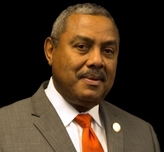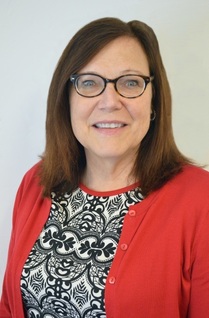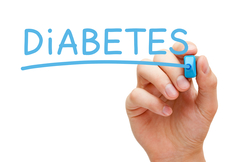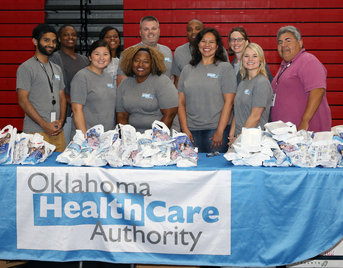|
Fall 2016

 |
|
In the OHCA Provider Checkup Newsletter (Fall 2016, Vol.1), we announced that Chief Dental Officer Dr. Leon Bragg would be retiring on October 31, 2016. We are pleased relay that, since that announcement, Dr. Bragg has suspended his retirement until next year. More details will be released at that time.
Back to top
|


The Oklahoma Health Care Authority (OHCA) Board offered State Medicaid Director Becky Pasternik-Ikard the chief executive officer position at their September 8 meeting held at the Children's Center Rehabilitation Hospital in Bethany, Okla.
The board met in executive session to discuss the vacancy created by the planned September 30 departure of CEO Nico Gomez. The board later voted unanimously to offer the CEO position to Pasternik-Ikard.
“Becky brings a wealth of experience to this position; she is a master’s level nurse and attorney," said Ed McFall, OHCA Board chair. "She has been with the agency from its infancy 22 years ago and has worked tirelessly for the Oklahomans enrolled in SoonerCare and Insure Oklahoma. Becky has shown a steadfast dedication to our programs which will help her lead the agency toward fulfilling our mission."
Pasternik-Ikard assumed the duties of CEO on October 4. Gomez vacated the position after three and a half years to become president and CEO of the Oklahoma Association of Health Care Providers. He announced his resignation on August 29.
Back to top
|


As October 31 approaches, you may observe that the pressure to consume sugar rapidly increases until January 1. I thought now would be a good time to refresh you on a couple of approaches to help stave off cavities that I got while visiting the Academy of General Dentistry.
1. Suggest healthy alternatives to candy.
Eating sweets causes damaging acids to form in the mouth that continue to affect the teeth for at least 20 minutes before they are neutralized. Sugar-free gum containing the artificial sweetener xylitol is effective in combating the bacteria in plaque and fighting the acid that eats away at enamel. The chewing motion also stimulates the flow of saliva, which helps cleanse the teeth. That makes sugar-free gum a smart choice to drop into Halloween bags.
2. Recommend limiting the amount of time sugar is in contact with a child’s teeth.
When buying candy, encourage parents to look for treats that can be eaten quickly, like miniature candy bars. Suggest discarding hard or sticky candies like sugared fruit snacks, caramels or lollipops, as they increase the time in which teeth are exposed to sugar. Children should be encouraged to eat only a small amount of candy in one sitting, followed by a glass of water and thorough tooth brushing. It is not a good idea to allow a child to graze on candy, as this will increase the amount of time sugar is in contact with teeth.
3. Remind parents that children should eat all foods in moderation.
Although sweets are blamed for much tooth decay, all foods — even healthy alternatives to candy, such as fruit and nuts — can promote tooth decay if eaten in excess. Children (like adults) should eat all foods in moderation. Reading nutrition labels can help families avoid foods and drinks loaded with sugar, fructose and other sweeteners.
4. Explain to parents how to set up a candy bank.
Ask parents to allow their child to make daily withdrawals from the bank and monitor the progress. This way, they can control how much candy the child consumes.
5. Take time to brush up on children’s oral health habits.
What better time than now to treat kids to a little reminder about the importance of healthy teeth and gums? Just a quick reminder of the importance of brushing, flossing and visiting the dentist is all that's needed to help your patients understand the importance of oral health. Treat them to a new toothbrush and some flavored floss to reinforce the habit of proper dental care.
6. Encourage use of fluoride to fight cavities.
The use of fluoride has been demonstrated to dramatically reduce the damage caused by tooth decay. The most common ways to use fluoride for cavity prevention are by using fluoridated toothpaste and by drinking fluoridated water.
It is always a good idea to remind parents that children should brush at least twice a day for two minutes, using a small (pea-sized) amount of fluoridated toothpaste and rinsing with a fluoridated mouthwash. Also, let them know that fluoride treatments are also available in your office.
Finally, ask parents to consider buying fluoridated bottled water or using fluoride supplements for their children if fluoridated water isn’t available in their area.
Dr. Leon Bragg
Chief Dental Officer
Information adapted from the Academy of General Dentistry.
Back to top
|
 
OHCA has opened dental code D1354 for use of silver diamine fluoride (SDF), for "interim caries arresting medicament application.” SDF is a major topic of discussion in dentistry lately. It has been described as “a caries ‘silver-fluoride bullet,’”1 and some have ventured to say it could eliminate the use of the drill altogether in treating children’s cavities.2
This cavity-fighting liquid has been used for decades internationally but has only been available for use in the U.S. for less than a year (under the brand name: Advantage Arrest). The U.S. Food and Drug Administration has approved the topical use of SDF to treat tooth hypersensitivity in adults, but studies show that SDF can not only stop the progression of cavities but can actually prevent them. Because of this, many dentists are using it for these purposes in pediatric patients. According to the New York Times, at least 18 dental schools in the U.S. approve of this off-label utilization and are training students how to use it.2
SDF is noninvasive, quick and inexpensive, which makes it an attractive option for treating Medicaid-eligible children.
Dental code D1354 can be used to bill for services provided to SoonerCare members. To limit any abuse, the following administrative rules are in place (subject to change):
- For a child who is documented to be unable to receive restorative services in the typical office environment;
- A tooth that has been treated with SDF should not have any non-carious structure removed;
- A tooth that has been treated with SDF should not receive any other permanent restorative treatment for three months following an application;
- Reimbursement for extraction of a tooth that has been treated with SDF will not be allowed for three months following an application;
- Reimbursement is available once every 184 days for two occurrences per tooth in a lifetime
- Reimbursement will be equal to that of a sealant, currently $22.56, limited to eight teeth per series
For more information on SDF and its use, you may want to read “UCSF Protocol for Caries Arrest Using Silver Diamine Fluoride: Rationale, Indications and Consent” (Horst JA, Ellenikiotis H, Milgrom PL. J Calif Dent Assoc. January 2016).
Sources:
1. Rosenblatt A, Stamford TC, Niederman R. Silver diamine fluoride: a caries "silver-fluoride bullet". J Dent Res. 2009 Feb;88(2):116-25. doi: 10.1177/0022034508329406.
2. Saint Louis C. A Cavity-Fighting Liquid Lets Kids Avoid Dentists' Drills. New York Times. July 11, 2016. Accessed September 28, 2016.
Back to top

All active orthodontic patients must be current with preventive services
The OHCA Dental Unit understands that referring general dentists and specialists often share oral care responsibilities for our SoonerCare members. We also recognize that our specialist partners regularly encourage members receiving specialty care to stay current with preventive services performed by the referring office. However, for some members receiving orthodontic services, we have noticed an unacceptable gap between periodic preventive services.
To address this issue of lack of preventive care, OHCA is temporarily suspending additional orthodontic extension requests until the member is up to date on the recommended preventive services. All members in active orthodontic care must receive an examination and prophylaxis a minimum of one time per year.
There is no need for the orthodontic provider to remove appliances or dismiss a patient who is not up to date on preventive services. However, OHCA recommends that the orthodontist refer the member back to their general dentist’s office for necessary preventive services while under specialty care. If the member has private insurance or another source that is not available per OHCA dental claims, the dental home or orthodontist office should document and submit the date and place of service prior to approval of any additional service time.
SoonerCare members must be caries free and in good gingival health to qualify for orthodontic services. It is our hope that this policy will help them remain in good oral health during orthodontic care and beyond.
Back to top
|
The OHCA Dental Unit implemented the use of its own caries risk assessment (CRA) form on May 1, 2016. We provided the form for the use of SoonerCare dental partners as a starting point for evaluating a patient's oral health status. The goal is to help open a dialogue with patients and their families.
The response has been very positive. In just three months (May 1 - July 31, 2016), OHCA paid 6,217 claims related to the CRA.
We thank providers for realizing the value in this tool and encourage its continued use. The CRA form and instructions are on our website. OHCA partner dentists are encouraged to complete and upload this information through the secure Provider Portal.
Back to top

On May 13, 2016, the U.S. Department of Health and Human Services (HHS) Office for Civil Rights (OCR) issued the final rule implementing of Section 1557, to improve health equity under the Patient Protection and Affordable Care Act (ACA). The final rule prohibits discrimination based on race, color, national origin, sex, age or disability; enhances language assistance for individuals with limited English proficiency; and protects individuals with disabilities. Sec. 1557 covers entities that receive financial assistance from or are administered by HHS. The rule went into effect on October 16, 2016.
The final rule helps consumers who seek to understand their rights and clarifies the responsibilities of health care providers and insurers that receive federal funds.
The final rule also prohibits discriminatory practices by health care providers, such as hospitals that accept Medicare or doctors who participate in the Medicaid program. Among the compliance requirements is that covered entities must "provide meaningful access to individuals with limited English proficiency." For providers, this may mean providing qualified interpreters and translators for your patients.
According to the ADA, “For dental practices that receive certain federal financial assistance from HHS, the Sec. 1557 final rule will require that they post notices of nondiscrimination as well as taglines in the top 15 non-English languages spoken in the state indicating that free language assistance services are available.” Get more details here.
There are a number of interpreter/translation services available for hire. A quick Internet search can get you on the road to compliance.
In addition, OCR has Sec. 1557 resources available here.
Back to top


November is American Diabetes Month. According to the American Diabetes Association, 29 million Americans live with this chronic condition. That equates to 1 in 11 Americans. The association believes that another 86 million Americans are at risk for developing diabetes.
Diabetes affects the way the body processes sugar and can cause problems with one’s eyes, heart, kidneys and mouth. The American Dental Association (ADA) states that people with diabetes are at greater risk of developing oral health problems such as gum disease and fungal infections. In fact, the ADA states that 1 in 5 cases of total tooth loss is linked to diabetes. Regular checkups and preventive screenings are crucial in maintaining the overall health of people living with diabetes.
According to the ADA, the following may happen if diabetes is untreated:
- One’s mouth may have less saliva, causing it to feel dry. (Dry mouth is also caused by certain medications.)
- Because saliva protects teeth, a person with diabetes is also at a higher risk of cavities.
- Gums may become inflamed and bleed often (gingivitis).
- One may have problems tasting food.
- One may experience delayed wound healing.
- It makes a person susceptible to infections inside of his or her mouth.
- For children with diabetes, teeth may erupt at an age earlier than is typical.
There are a number of free resources to help your patients manage diabetes. First, the SoonerCare Health Management Program (HMP) produced a video with helpful tips and information you can share. You may watch it online here, or you can request a copy of the 10-minute video from your provider representative (while supplies last). There are also several educational patient handouts available for download at on our website at www.okhca.org/diabetes.
Patients may also want to check out “Diabetes and Oral Health Problems” from the American Diabetes Association and “Diabetes and Your Smile” from the ADA.
“Smile! Dentists and Doctors Can Both Help With Diabetes” (ADA) offers helpful information for providers.
Back to top
|


OHCA helped 500 students at Riverside Indian Boarding School to start their school year with healthier smiles at the 10th annual Riverside Dental Event on September 2.
Students received dental hygiene tools and full health screenings provided by the OHCA and our community partners. Services offered included eye screenings, behavioral health screenings and body mass index (BMI) measurements, as well as education on general health issues.
OHCA staff members have been involved in organizing this event, providing toothbrushes, toothpaste and dental floss with the help of sponsor Colgate-Palmolive. Other partners in the event were the Indian Health Service, Oklahoma State Department of Health, Southern Plains Tribal Health Board, Blue Cross Blue Shield, and the Absentee Shawnee Tribe of Oklahoma.
“OHCA is just one of many partners that come together for the sole purpose of improving the wellness of these kiddos at Riverside,” said Dana Miller, director of Tribal Governmental Relations for OHCA. “We don’t receive extra funding and are not mandated by law to do this event. This all comes from a sense of duty to our members and supporting the community.”
|

Back to top
 
OHCA Provider Helpline: 800-522-0114
Dental Prior Authorization Unit: 405-522-7401
|